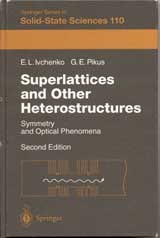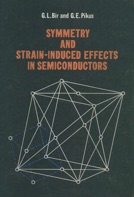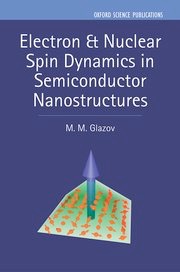Sector of Theory of Quantum Coherent Phenomena in Solids

E.L. Ivchenko, G.E. Pikus, "Superlattices and Other Heterostructures. Symmetry and Optical phenomena”
Springer, 1sted. 1995, 2nded. 1997
Full text can be downloaded by this link (pdf)
E.L. Ivchenko, "Optical Spectroscopy of Semiconductor Nanostructures"
Alpha Science (Harrow, UK), 2005
M.M. Glazov, "Electron & nuclear spin dynamics in semiconductor nanostructures" OUP google books
Oxford University Press (Oxford, UK), 2018

Superlattices and Other Heterostructures deals with optical properties of superlattices and quantum-well structures with emphasis on phenomena governed by crystal symmetries. After a brief introduction into group theory and symmetries, methods to calculate spectra of electrons, excitons and phonons in heterostructures are discussed. Further chapters cover absorption and reflection of light under interband transitions, cyclotron and electron spin-resonance, light scattering by free and bound carriers as well as by optical and acoustic phonons, polarized photoluminescence, optical spin orientation of electrons and excitons, and nonlinear optical and photogalvanic effects.
Optical Spectroscopy of Semiconductor Nanostructures is an attempt to create an impression of the contemporary optical spectroscopy of semiconductor nanostructures. It reviews new trends and notable progress attained in the field at the beginning of the third millennium. The book reflects the success achieved during the recent decade in various optical studies of semiconductor nanostructures.
Now the one- and zero-dimensional structures, quantum wires and quantum dots, are presented on an equal footing, alongside of superlattices and two-dimensional systems, heterojunctions and quantum wells. New concepts and phenomena included into consideration are exciton polaritons in resonant Bragg structures and photonic crystals, the strong Rabi splitting in quantum microcavities, trions, micro-photoluminescence of localized excitons in quantum wells, zero-dimensional excitons in quantum dots, giant magneto-optical effects in semimagnetic nanostructures, interface-induced lateral optical anisotropy, quantum-confined Pockels effect, chirality effects in carbon nanotubes, polariton-polariton scattering in the microcavities, etc. Moreover, in connection with the increasing interest in spintronics, special attention is paid to spin-related concepts and spin-dependent phenomena, including the spin split- ting of electron and hole subbands, fine structure of excitonic levels, optical orientation of free-carrier spins and exciton angular momenta under inter- and intraband photoexcitation, sensitivity of the Zeeman spin splitting to the content, size and shape of a nanostructure, spin relaxation mechanisms, spin quantum beats, spin dynamics of exciton polaritons in the microcavities, circular photogalvanic and spin-galvanic effects in quantum wells.

G.L. Bir, G.E. Pikus,
"Symmetry and strain-induced effects in semiconductors”
М. Наука (1972), John Wiley and Sons (1974)
Russian full text can be downloaded by this link (djvu)
English full text can be downloaded by this link (djvu)

In recent years, the physics community has experienced a revival of interest in spin effects in solid state systems. On one hand, solid state systems, particularly semicon- ductors and semiconductor nanosystems, allow one to perform benchtop studies of quantum and relativistic phenomena. On the other hand, interest is supported by the prospects of realizing spin-based electronics where the electron or nuclear spins can play a role of quantum or classical information carriers. This book aims at rather detailed presentation of multifaceted physics of interacting electron and nuclear spins in semiconductors and, particularly, in semiconductor-based low-dimensional structures. The hyperfine interaction of the charge carrier and nuclear spins increases in nanosystems compared with bulk materials due to localization of electrons and holes and results in the spin exchange between these two systems. It gives rise to beautiful and complex physics occurring in the manybody and nonlinear system of electrons and nuclei in semiconductor nanosystems. As a result, an understanding of the intertwined spin systems of electrons and nuclei is crucial for in-depth studying and control of spin phenomena in semiconductors. The book addresses a number of the most prominent effects taking place in semiconductor nanosystems including hyperfine interaction, nuclear magnetic resonance, dynamical nuclear polarization, spin-Faraday and -Kerr effects, processes of electron spin decoherence and relaxation, effects of electron spin precession mode-locking and frequency focusing, as well as fluctuations of electron and nuclear spins.
